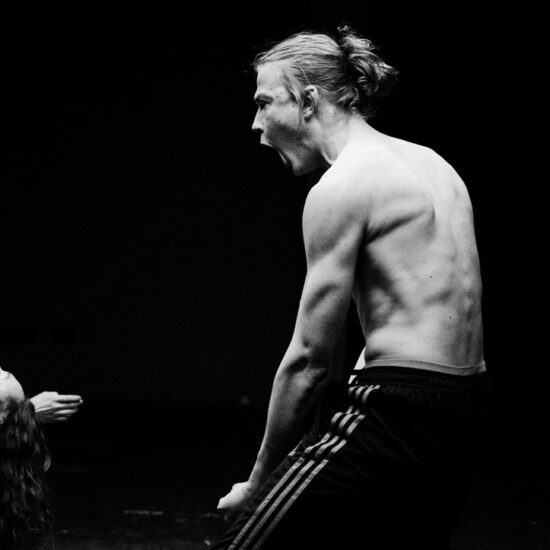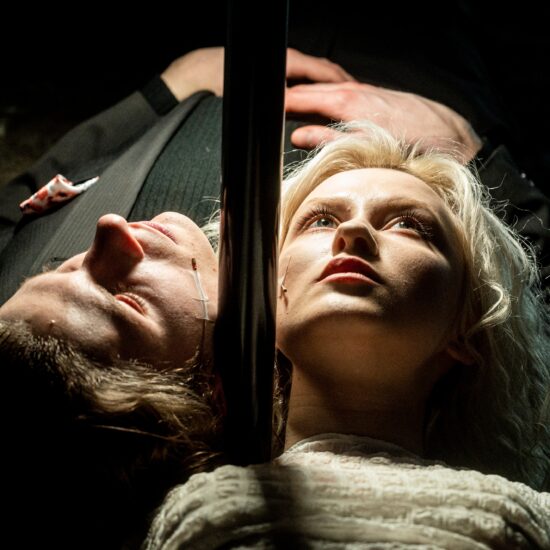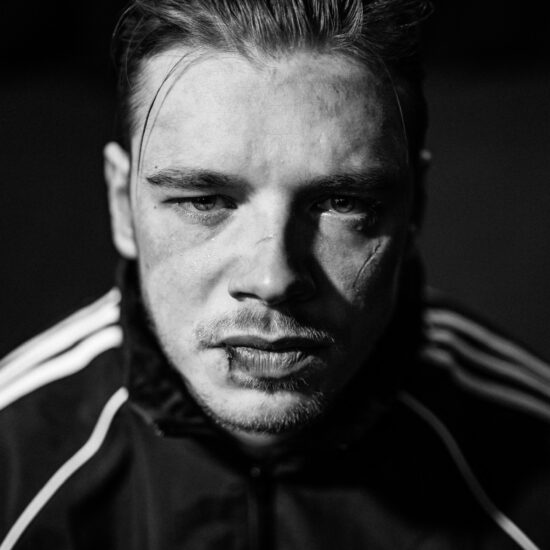FIREFACE
This project is being realized together with Goethe institute (Vilnius) and Lithuanian National drama theatre.
The co-producer of the performance – Kleist Theatre, Frankfurt/Oder (Germany).
Dramatist Marius von Mayenburg: While I’m writing a play, I never think if it’s modern or not. What distinguishes me from the older generation of dramatists is first of all the fact that the latter mainly deal with ideas and ideology in general. I think that new dramaturgy does not believe in ideology. That is why the mode of writing itself has changed: conflicts are represented, and the human body has become one of the key motifs.
I don’t aim to produce a shock effect. As a matter of fact, I am ruled by fear, whose reasons I’m trying to find out. In the process of searching for reasons I face violence, against which there is no medicine. As I ponder on the origins of aggression, I try to think about the worst possible outcome.
Director Oskaras Korsunovas: This play by Marius von Mayenburg enabled me to continue the search for the contemporary theatre idiom. An idiom articulating premonition, horror and neurotic moments of our civilization. Marius von Mayenburg enabled me to further explore the way of contemporary dramaturgy, the landmarks of which have been set by Sigitas Parulskis, Bernard-Marie Koltčs and Mark Ravenhill.
Set designer Jurate Paulekaite: I prefer not to comment on the motifs of choosing the material or what we find important in it and in what way we want to express it. Commentaries, instructions of reading a work only limit the field of interpretation for the spectator. Particularly in the case of this play. To explain that you are on nobody’s side, or in fact you probably are on somebody’s side… Even the statement that it’s nobody’s fault is already a dogma. This is not what I’d like.
Composer Gintaras Sodeika: Excerpts, parts, fragments, elements, adaptations, dramatizations – all these are forms with which we have been familiar until now… “Feuergesicht” is a “scanned” or “sampled” reality, and you can’t escape feeling part of it.
THEATRE CRITICS ABOUT “THE FACE OF FIRE”:
“It is not a corpse but rather a dump of values on the stage. From family silver on a wild boar’s hide, banal kitchen furniture and living room sofas to a canoe and a satellite antenna. Familiar objects are made to exist in an unfamiliar density.
By the finale the director shows us that nothing can be destroyed. Confrontation is eternal. You can kick it away, you can kill and burn it down, but you won’t make it disappear.”
Ruta Oginskaite. A Dump of Wealth and a Hunt for the Norm // Lietuvos rytas, 02-05-2000
“Korsunovas’ theatre is not a place of spiritual resistance where a “unique world” is created and its varieties are offered for the audience. Korsunovas offers a theatre constructed from “the world”. One of the most attractive qualities of Korsunovas’ theatre (particularly for an ordinary spectator rather than a critic) is the fact that he does not introduce himself but offers the pleasure of recognition. This director is one of the few in Lithuania who does not identify himself with his characters.”
Rasa Paukstytė. Variations of Kay and Gerda // Literatūra ir menas, 05-05-2000
“In two months the director Oskaras Korsunovas not only produced a performance, but also created an artwork of astonishing openness and ability to see an individual from so close.
It is common in art to represent what has already been experienced. This time Korsunovas does not run – he rushes headlong on a bike on unfamiliar paths. It is probably the greatest satisfaction that art can offer.
The fire theme of Marius von Mayenburg and Oskaras Korsunovas has to do with prophesies of the great astrologers, especially Rerichists, claiming that the world is bound to be destroyed by fire. Korsunovas does not actually start a fire – it is the composer Gintaras Sodeika who makes it burn; with the aim of keeping the other senses (not only the eyes and ears) occupied during the performance, the director sprays some petrol. Spectators who have weak nerves make their way out of the hall, and they are perfectly right, as the risk factor is always so close, – after all, this is what the performance is all about.”
Daiva Sabaseviciene. Oskaras Korsunovas’ Study of Man // 7 meno dienos, 05-05-2000
Oskaras Korsunovas nourishes himself on and enjoys these drastic situations and events, this truth, that killed other playwrights, touching the rough surface of the reality, for example, Sarah Cane. “I am writing the truth, and this kills me”. On the contrary. Aggression, incest, massacre inspire the director. Alike on the skating-board from “Roberto Zucco”, Kurt and Olga in “The Face of Fire” move by the similar trajectory: from the bottom to the top and once again from the top to the bottom. They are forcing their way through the furniture to the top of the cupboard, sticking out as the antique column, on its highest point; the heroes are enjoying one another, and the director is enjoying them. Kurt is burning himself on the top, and Olga – being rescued by Paul – is pulled on the earth. Because this specific, theatrical, romantic pathos of the director (it is more close to “Roberto Zucco” than to “Shopping and Fucking”) pyromania of Kurt takes off above the every-day drama and becomes a metaphor or whim. This metaphor is stressed by the final smell of petrol <…> A thing, a living being, a smell, pulled ashore from its natural environment, acquire the new meaning. With the help of this well understood axiom Oskaras Korsunovas testifies the origin of the theatre.
Rasa Paukstyte, Variations of Kay and Gerda, Literatura ir menas 2000 05 05
The theme of fire in the piece of M. von Mayenburg and Oskaras Korsunovas is related to the prophesies of astrologists proclaiming the end of the world namely in the fire. Nevertheless Korsunovas does not make fire – it is being made by a composer Gintaras Sodeika, and the director spreads the smell of petrol to satisfy the other human sensations, not only eyes and ears. The spectators of a weaker nerve are leaving the hall, and they are absolutely right, because the factor of risk is always very close to us. Besides, the performance deals with this idea. It is natural, that in this kind of theatre the actors are the “demiurgs”. They are simply “bathing” in their roles, knowing, that they will not get drowned, because their environment is very concrete, and the director has provided them with a very precise trajectory of the movement. The most important factor of risk – complicated physical obstacles. Every inaccurate jump on, let’s say, a moving cupboard, could end with an accident. Director always liked the very well prepared actors, but after the “Midsummer Night’s Dream” he just became spoilt. The actors showed all-round preparedness and the ability to be on the stage continuously moving with boards and among the boards in “Midsummer Night’ Dream”, and they encouraged the director to “squeeze” them even more resolutely in the “Face of Fire”.
Daiva Sabaseviciene, The Research of a Human-Being by Oskaras Korsunovas, 7 Meno dienos, 2000 05 05
The story of a family frozen in fire
The acting is bursting with energy. The acting unconditionally prevails, the virtuosity of five actors is astounding , it lends a breathtaking rhythm to Marius von Mayenburg’s play. Their flexibility and agility have no limits – they can fly across the stage taking off from the trash heap amassed in their home, keep balance in running or simply climb onto the very top of raised furniture.
The direction of Oskaras Korsunovas is mercilessly strict, influential, without a single deviation. Such mastery, the freedom of gestures and such tone is breathtaking. The strength of this theatre is in the mechanism of acting, which cannot be distracted by anything, and in devilish precision, which sets imagination free.
L’Humanite, Zoe Lin, 16 07 2001
Hot!
In this staging Marius von Mayenburg’s play “Fireface” is devoid of deceiving luster and elegant minimalism – today we see it the way it really is. Korsunovas’ staging depicts all its cruelty, allowing us to feel the smell of burning bodies, shows its nightmarish fury.
Korsunovas decides to devote all the attention to actors and that’s his merit: they blaze, burn as if on fire and breathe flames. The bubbling of a hellish cauldron repeats the rhythm of the action – actors create it; that weighty, primal fire swallows them up and they are the ones who stoke the fire.
Le Figaro, 16 07 2001, Frédéric Ferney
Set designer
Juratė Paulekaitė
Composer
Gintaras Sodeika
Cast
FATHER - Remigijus Vilkaitis, Arvydas Dapsys
KURT - Gytis Ivanauskas
MOTHER - Dalia Brenciute
OLGA - Rasa Samuolyte
PAUL - Dainius Gavenonis
Premiere
2000 April 27



